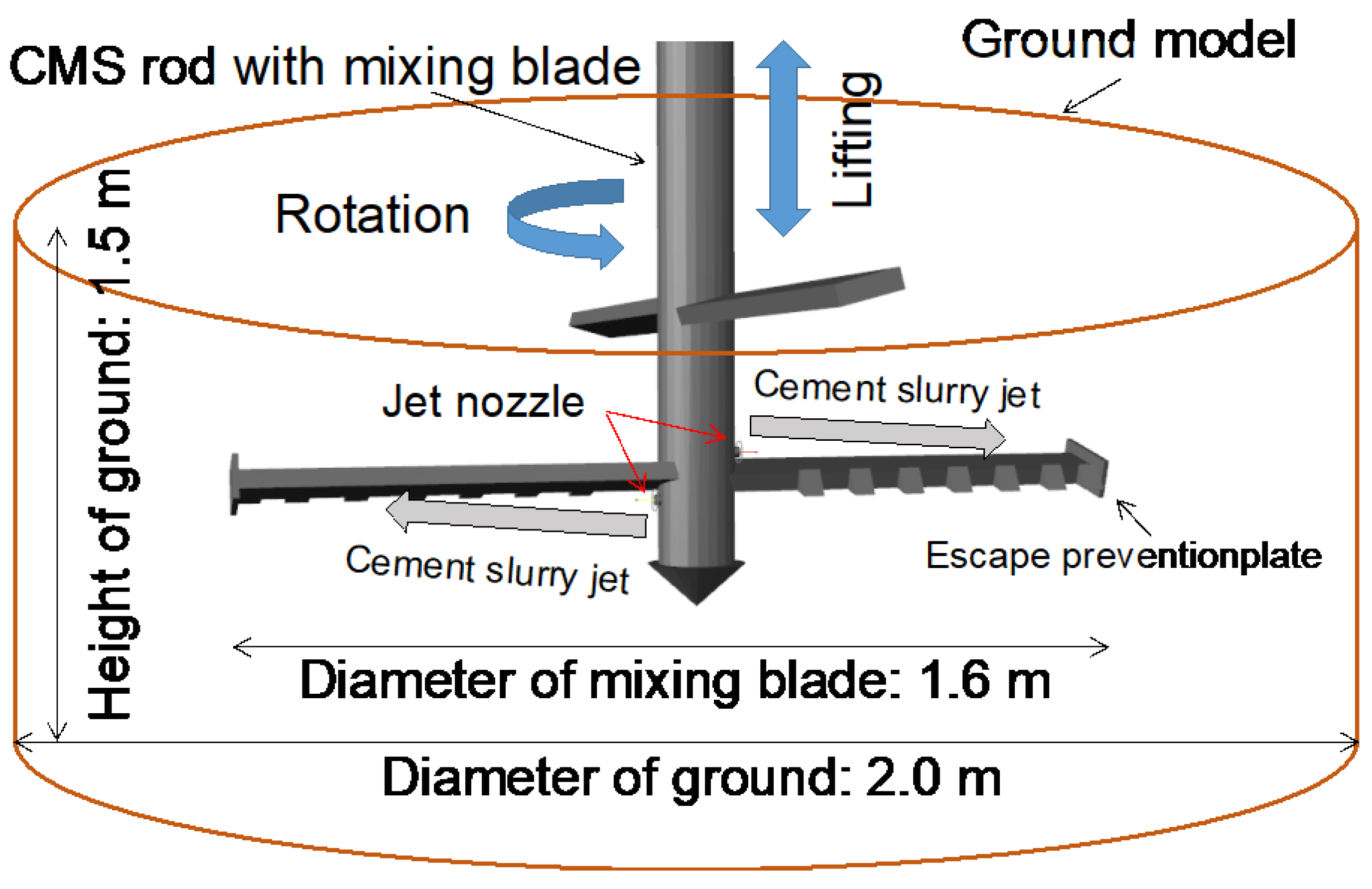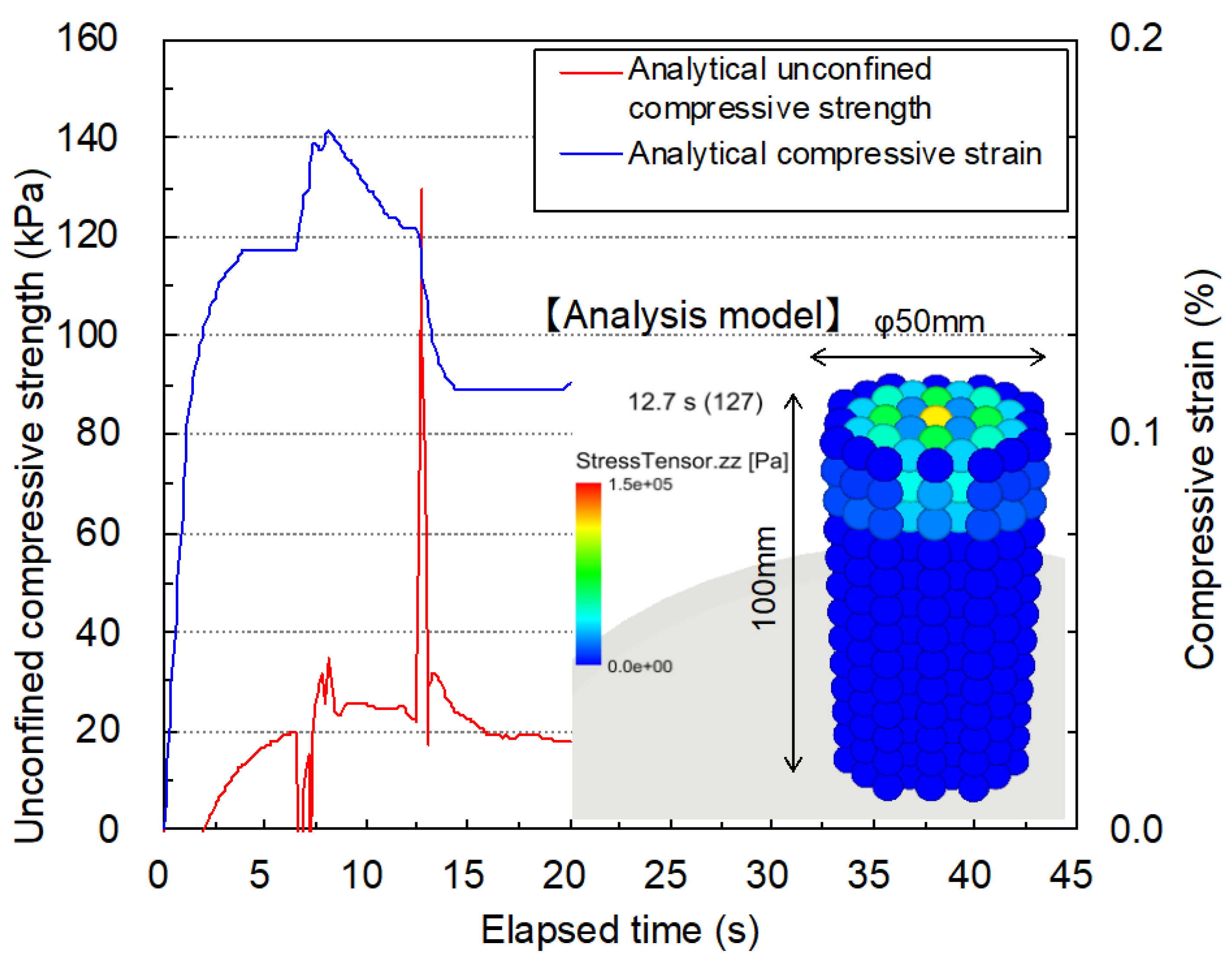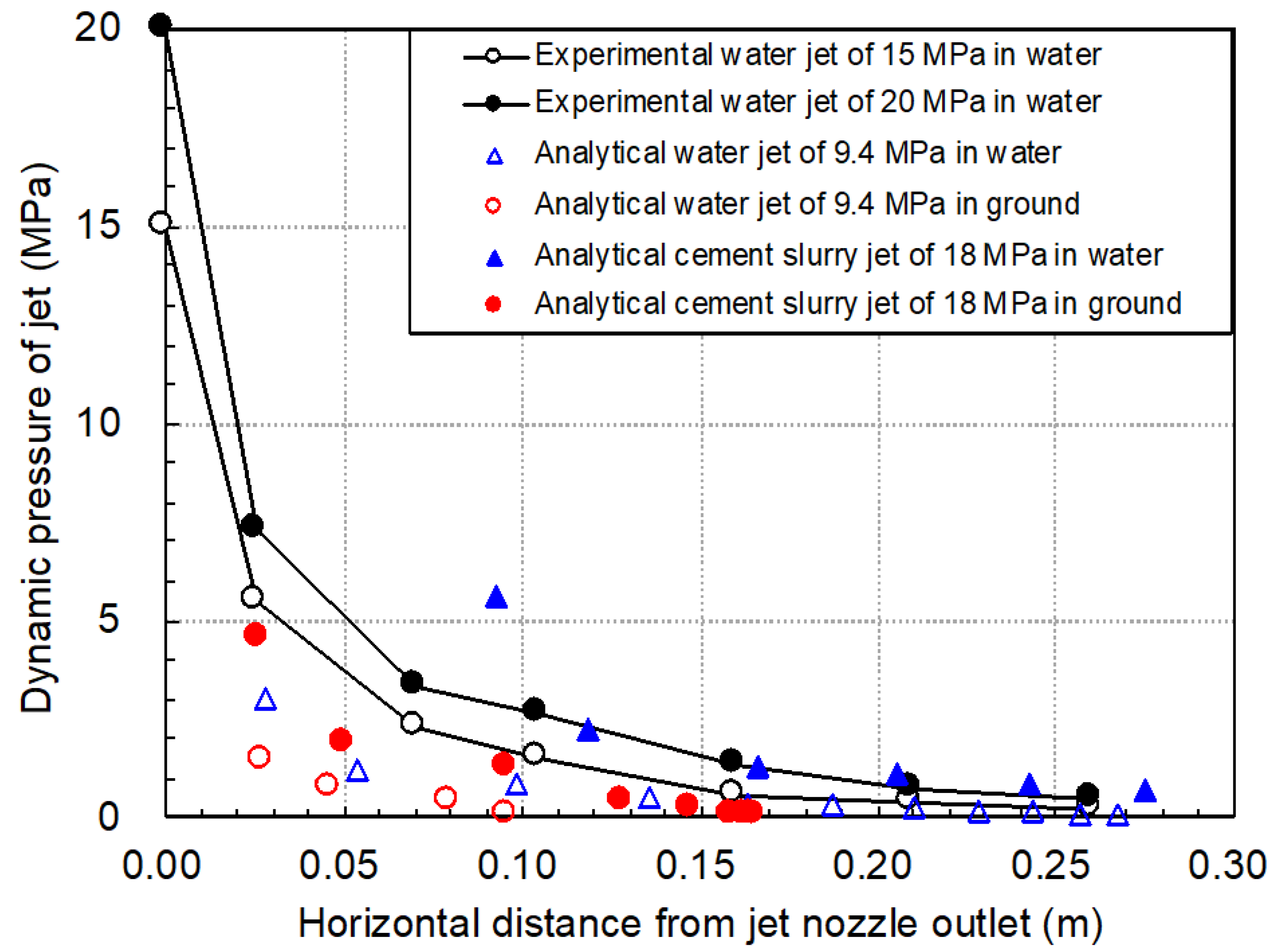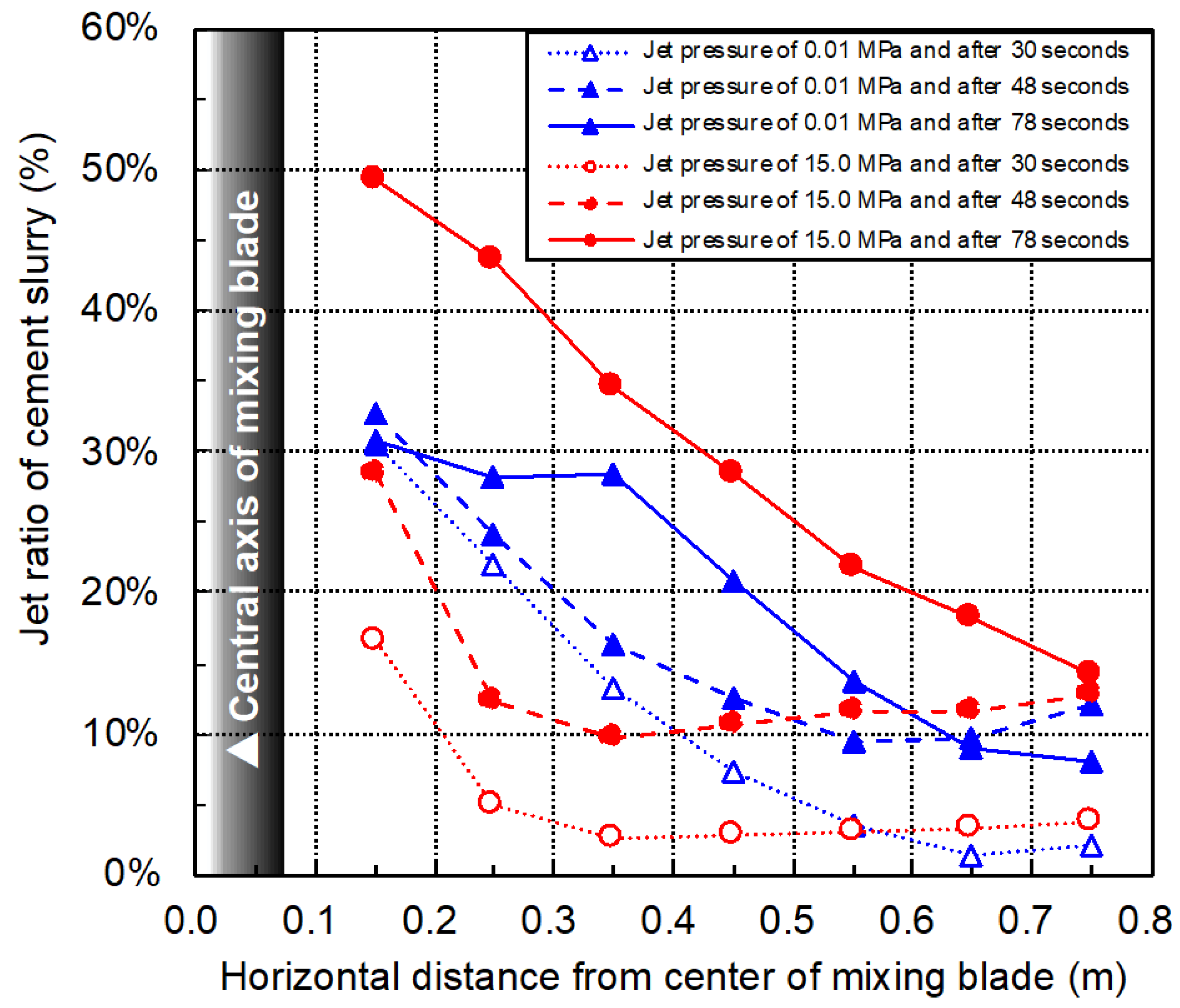Numerical Analysis on Performance of the Middle-Pressure Jet Grouting Method for Ground Improvement
Abstract
:1. Introduction
2. CAE with MPS Method
2.1. Computer-Aided Engineering (CAE)
2.2. Particle Method and Moving Particle Semi-Implicit Method (MPS)
3. Outline of Middle-Pressure Jet Grouting Method
4. Analysis Conditions for MPS-CAE
4.1. Modeling the Analysis Target
4.2. Material Parameters
4.3. Validation of Analytical Model
5. CAE Analysis Results and Discussions
5.1. Reproduction of Development Situation of Columnar Soil-Improved Body by Jet Grouting Method
5.2. Reproduction of Development Situation of Columnar Soil-Improved Body by Jet Grouting with Mechanical Agitation and Mixing Method
5.3. Performance Evaluation of Jet Grouting with Mechanical Agitation and Mixing Method
6. Conclusions
- (1)
- The mechanical properties of the ground model were estimated by a reconstructive analysis of unconfined compression tests on soil.
- (2)
- The jet behavior of the water and the cement slurry model was verified by a jet analysis of a stationary fluid.
- (3)
- The final shape of the columnar soil-improved body, obtained by a reproduction analysis of the jet grouting method, was about the same as the design improvement diameter at an actual site.
- (4)
- Modeling of the ground particles is one of the reasons why the sludge discharge situation by the jet grouting method cannot be reproduced.
- (5)
- In the reproduction analysis of the jet grouting with mechanical agitation and mixing method, by using the middle-pressure jet grouting together with the mechanical agitation and mixing method, the cement slurry jet ratio in the planned improvement range, including the periphery of the mixing blade, was increased and a high quality columnar soil-improved body was obtained.
- (6)
- It is expected that the introduction of CAE will contribute to the visualization of the ground, and it is suggested that CAE be used as an effective tool for the visual management of ground-improvement construction and the maintenance of improved grounds in the life cycle.
Author Contributions
Funding
Institutional Review Board Statement
Informed Consent Statement
Data Availability Statement
Conflicts of Interest
References
- Atangana Njock, P.G.; Chen, J.; Modoni, G.; Arulrajah, A.; Kim, Y.H. A review of jet grouting practice and development. Arab. J. Geosci. 2018, 11, 459. [Google Scholar] [CrossRef]
- Atangana Njock, P.G.; Shen, J.S.; Modoni, G.; Arulrajah, A. Recent Advances in Horizontal Jet Grouting (HJG): An Overview. Arab. J. Sci. Eng. 2018, 43, 1543–1560. [Google Scholar] [CrossRef]
- Modoni, G.; Croce, P.; Mongiovì, L. Theoretical modelling of jet grouting. Géotechnique 2016, 56, 335–347. [Google Scholar] [CrossRef]
- Modoni, G.; Wanik, L.; Giovinco, G.; Bzówka, J.; Leopardi, A. Numerical analysis of submerged flows for jet grouting. Proc. Inst. Civ. Eng. Ground Improv. 2016, 169, 42–53. [Google Scholar] [CrossRef] [Green Version]
- Nakanishi, W.; Nakazawa, J. The process of development on jet grouting methods and their future. Soil Mech. Found. Eng. 2006, 54, 10–12. [Google Scholar]
- Pinto, A.; Falcão, J.; Pinto, F.; Melo Ribeiro, J. Ground improvement solutions using jet grouting columns. In Proceedings of the 16th International Conference on Soil Mechanics and Geotechnical Engineering, Osaka, Japan, 12–16 September 2005; pp. 1249–1252. [Google Scholar]
- Shen, S.L.; Njock, P.G.A.; Zhou, A.; Lyu, H.M. Dynamic prediction of jet grouted column diameter in soft soil using Bi-LSTM deep learning. Acta Geotech. 2012, 16, 303–315. [Google Scholar] [CrossRef]
- Shen, S.L.; Wang, Z.F.; Yang, J.; Ho, C.E. Generalized approach for prediction of jet grout column diameter. J. Geotech. Geoenviron. Eng. 2013, 139. [Google Scholar] [CrossRef]
- Burke, G.K. Jet Grouting Systems: Advantages and Disadvantages. In GeoSupport 2004: Drilled Shafts, Micropiling, Deep Mixing, Remedial Methods, and Specialty Foundation Systems; Turner, J.P., Mayne, P.W., Eds.; American Society of Civil Engineers: Reston, VA, USA, 2004. [Google Scholar]
- Harada, K.; Ohbayashi, J.; Matsumoto, J.; Kubo, Y.; Akima, T. New ground improvement technologies under restricted conditions in Japan. Jpn. Geotech. Soc. Spec. Publ. 2015, 2, 1165–1170. [Google Scholar] [CrossRef] [Green Version]
- Pinto, A.; Tomásio, R.; Marques, G. Ground improvement with jet grouting solutions at the new cruise terminal in Lisbon, Portugal. Procedia Eng. 2016, 143, 1495–1502. [Google Scholar] [CrossRef] [Green Version]
- Wang, Z.F.; Bian, X.; Wang, Y.Q. Numerical approach to predict ground displacement caused by installing a horizontal jet grout column. Mar. Georesour. Geotechnol. 2017, 35, 970–977. [Google Scholar] [CrossRef]
- Wang, Y.; Li, L.; Li, J.; Sun, D. Jet-grouting in ground improvement and rotary grouting pile installation: Theoretical analysis. Geomech. Eng. 2020, 21, 279–288. [Google Scholar]
- Zhang, W.; Li, Y.; Goh, A.; Zhang, R. Numerical study of the performance of jet grout piles for braced excavations in soft clay. Comput. Geotech. 2020, 124, 103631. [Google Scholar] [CrossRef]
- Zhang, W.; Hong, L.; Yongqin, L.; Zhang, R.; Goh, A.T.C. Assessment of effect of jet grouting slabs on responses for deep braced excavations. Undergr. Space 2021, 6, 185–194. [Google Scholar] [CrossRef]
- Komaki, T.; Fukada, S.; Shimano, A.; Nakanishi, Y. Efficient of Mechanical mixing method with middle pressure injection by High performance fluidizing agent. In Proceedings of the 13th National Symposium on Ground Improvement, Kyoto, Japan, 24–26 October 2018; pp. 375–378. [Google Scholar]
- Komaki, T.; Fukada, S.; Sumi, K.; Nakanishi, Y.; Tanaka, N. Demonstration experiment of evolution technology by combination mixing slurry of middle pressure injection total system. In Proceedings of the 53th Japan National Conference on Geotechnical Engineering, Takamatsu, Japan, 24–26 July 2018; pp. 835–836. [Google Scholar]
- Hattori, M. An attempt to apply mathematical foundation of Moving Particle Simulation to the MPS software “Particleworks”. Proc. Symp. Educ. Appl. Inf. Technol. 2015, 9, 59–62. [Google Scholar]
- Shakibaeini, A.; Jin, Y.C. MPS mesh-free particle method for multiphase flows. Comput. Methods Appl. Mech. Eng. 2012, 229–232, 13–26. [Google Scholar] [CrossRef]
- Tanaka, M.; Cardoso, R.; Bahai, H. Multi-resolution MPS method. J. Comput. Phys. 2018, 359, 106–136. [Google Scholar] [CrossRef]
- Chang, K.H. Product Design Modeling Using CAD/CAE: The Computer Aided Engineering Design Series; Elsevier: Amsterdam, The Netherlands, 2014. [Google Scholar]
- Hamri, O.; Léon, J.C.; Giannini, F.; Falcidieno, B. Advances in Engineering Software Software environment for CAD/CAE integration. Adv. Eng. Softw. 2010, 41, 1211–1222. [Google Scholar] [CrossRef]
- Inazumi, S.; Kuwahara, S.; Jotisankasa, A.; Chaiprakaikeow, S. MPS-CAE simulation on dynamic interaction between steel casing and existing pile when pulling out existing piles, International Journal of GEOMATE: Geotechnique. Constr. Mater. Environ. 2020, 18, 68–73. [Google Scholar]
- Pan, Z.; Wang, X.; Teng, R.; Cao, X. Computer-aided design-while-engineering technology in top-down modeling of mechanical product. Comput. Ind. 2016, 75, 151–161. [Google Scholar] [CrossRef]
- Yang, P.; Zang, M.; Zeng, H. DEM-FEM simulation of tire-sand interaction based on improved contact model. Comput. Part. Mech. 2020, 7, 629–643. [Google Scholar] [CrossRef]
- Inazumi, S.; Komaki, T.; Nakanishi, Y.; Hashida, H.; Suzuki, M. Qualities evaluation on high pressure Jet mixing ground improvement methods by distinct element method (DEM). In Proceedings of the 13th National Symposium on Ground Improvement, Kyoto, Japan, 24–26 October 2018; pp. 211–216. [Google Scholar]
- Shimano, A.; Yamazaki, J.; Shinsaka, T. The study about work progress control of jet grouting method. In Proceedings of the 12th National Symposium on Ground Improvement, Okayama, Japan, 12 September 2016; pp. 455–458. [Google Scholar]
- Shinsaka, T.; Yamazaki, J.; Nakanishi, Y.; Komiya, K. Quality control and shape control techniques in jet grouting. In IFCEE 2018: Innovations in Ground Improvement for Soils, Pavements, and Subgrades; Stuedlein, A.W., Lemnitzer, A., Suleiman, M.T., Eds.; American Society of Civil Engineers: Reston, VA, USA, 2018. [Google Scholar]
- Güllü, H. A new prediction method to rheological behavior of grout with bottom ash for jet grouting columns. Soils Found. 2017, 57, 384–396. [Google Scholar] [CrossRef]
- Güllü, H.; Cevik, A.; Al-Ezzi, K.M.; Gülsan, M.E. On the rheology of using geopolymer for grouting: A comparative study with cement-based grout included fly ash and cold bonded fly ash. Constr. Build. Mater. 2019, 196, 594–610. [Google Scholar] [CrossRef]
- Kamalova, Z.; Hatanaka, S. Moving particle simulation for a simplified permeability model of pervious concrete. Comput. Concr. 2019, 24, 571–578. [Google Scholar]
- Croce, P.; Flora, A. Analysis of single-fluid jet grouting. Géotechnique 2000, 50, 739–748. [Google Scholar] [CrossRef]
- Croce, P.; Flora, A.; Modoni, G. Jet Grouting: Technology, Design and Control; CRC Press: Boca Raton, FL, USA, 2014. [Google Scholar]









| Case of Analysis | Case 1 | Case 2 | Case 3 | Case 4 | Case 5 | Case 6 | Case 7 | |
|---|---|---|---|---|---|---|---|---|
| Method of construction | QSJ | QSJ | QSJ | QSJ | QSJ | CMS | CMS | |
| Range of target | Water | Water | Ground | Ground | Ground | Ground | Ground | |
| Material of jet | Water | Cement slurry | Water | Cement slurry | Water *1 | Cement slurry *2 | Cement slurry | Cement slurry |
| Length of penetration while blanking (m) | 0.5 | 0.5 | 0.5 | 0.5 | 0.5 | 0.5 | 0.5 | 0.5 |
| Length of penetration while improving soil (m) | - | - | - | - | 0.5 | 0.5 | 0.5 | 0.5 |
| Amount of jet (L/min) | 80 | 90 | 80 | 90 | 80 | 90 | 80 × 2 | 80 × 2 |
| Pressure of jet (MPa) | 9.4 | 18.0 | 9.4 | 18.0 | 9.4 | 18.0 | 15.0 | 0.01 |
| Velocity of jet (m/s) | 137.5 | 155.0 | 137.5 | 155.0 | 137.5 | 155.0 | 141.5 | 4.2 |
| Velocity of penetration while blanking (m/min) | - | - | - | - | 6.0 | - | 10.0 | 10.0 |
| Velocity of penetration while improving soil (m/min) | - | - | - | - | 6.0 | - | 0.67 | 0.67 |
| Velocity of lifting while improving soil (m/min) | - | - | - | - | - | 0.33 | 1.0 | 1.0 |
| Velocity of rotation (rpm) | - | - | - | - | 80 | 20 | 20 | 20 |
| Range of Target | Density (kg/m3) | W/C (-) | Yield Value (Pa) | Plastic Viscosity (Pa·s) | Yield Point (-) | Fluid Model |
|---|---|---|---|---|---|---|
| Water | 1000 | - | - | - | - | Newtonian fluid |
| Cement slurry | 1500 | 1.0 | 10 | 0.28 | 0.0001 | Bingham fluid |
| Ground | 1600 | - | 1,000,000 | 1000 | 0.0001 | Bingham fluid |
Publisher’s Note: MDPI stays neutral with regard to jurisdictional claims in published maps and institutional affiliations. |
© 2021 by the authors. Licensee MDPI, Basel, Switzerland. This article is an open access article distributed under the terms and conditions of the Creative Commons Attribution (CC BY) license (https://creativecommons.org/licenses/by/4.0/).
Share and Cite
Inazumi, S.; Shakya, S.; Komaki, T.; Nakanishi, Y. Numerical Analysis on Performance of the Middle-Pressure Jet Grouting Method for Ground Improvement. Geosciences 2021, 11, 313. https://doi.org/10.3390/geosciences11080313
Inazumi S, Shakya S, Komaki T, Nakanishi Y. Numerical Analysis on Performance of the Middle-Pressure Jet Grouting Method for Ground Improvement. Geosciences. 2021; 11(8):313. https://doi.org/10.3390/geosciences11080313
Chicago/Turabian StyleInazumi, Shinya, Sudip Shakya, Takahiro Komaki, and Yasuharu Nakanishi. 2021. "Numerical Analysis on Performance of the Middle-Pressure Jet Grouting Method for Ground Improvement" Geosciences 11, no. 8: 313. https://doi.org/10.3390/geosciences11080313






